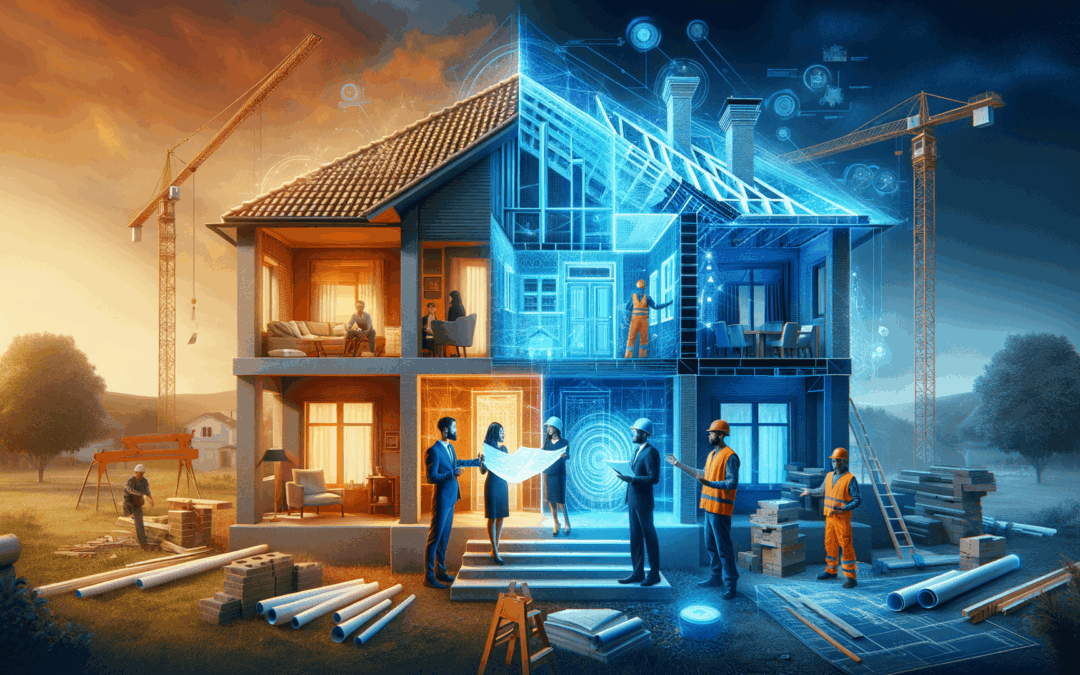
May 14, 2025 | Specific Project Types & Applications:
Structural Considerations for Residential Home Additions and Renovations
Adding to or renovating your home can transform it significantly, enhancing both its functionality and aesthetics. However, successful projects require more than just a keen eye for design; they demand careful consideration of structural elements. Understanding these structural considerations can ensure that your home addition or renovation is safe, sustainable, and adds value to your property.
Understanding the Role of a Structural Engineer
When embarking on a home addition or renovation project, it’s crucial to hire a structural engineer. These professionals are pivotal in assessing the structural integrity of your existing home and designing modifications that ensure its continued safety and stability.
Why Hire a Structural Engineer?
- Evaluation of Load-Bearing Walls: One of the structural engineer’s primary tasks is to identify and evaluate load-bearing walls. Removing or altering these walls can compromise the stability of your entire home.
- Foundation Assessment: An engineer can evaluate whether the existing foundation can support additional loads from a renovation or addition, or if reinforcement is necessary.
- Compliance with Building Codes: Structural engineers ensure that your project adheres to local building codes and regulations, avoiding potential legal complications.
- Innovative Design Solutions: With their expertise, structural engineers can provide creative solutions to complex design challenges, ensuring both functionality and aesthetic appeal.
Key Structural Considerations
1. Load Distribution
Understanding how loads are distributed in your home is crucial. Additions can alter the load paths, impacting the structural integrity. Proper load distribution ensures that weight is carried effectively to the foundation.
2. Foundation Requirements
The foundation is vital as it supports the entire structure. When planning an addition, it’s essential to determine whether the current foundation can handle new loads or if upgrades are needed.
- Soil Testing: Conduct thorough soil analysis to determine the soil’s bearing capacity and necessary foundation modifications.
- Foundation Reinforcement: Consider underpinning or reinforced concrete footings for added support.
3. Material Selection
Choosing appropriate materials is key to ensuring durability and stability. Commonly considered factors include:
- Compatibility: New materials should harmoniously integrate with existing structures.
- Load-Bearing Capacity: Ensure materials chosen can sustain new and existing loads.
- Environmental Considerations: Sustainable materials can enhance energy efficiency and reduce overall environmental impact.
4. Structural Connections
Connections between existing and new structures are critical. They must be robust to prevent separation under stress or adverse weather conditions.
- Seismic Considerations: In earthquake-prone areas, ensure connections can withstand seismic forces.
- Weather Resilience: Protect against thermal expansion, contraction, and moisture-related issues.
5. Roof Modifications
If your project involves roof alterations, consider how these changes will affect the overall structure.
- Load-Bearing Capacity: Calculate how new elements, such as dormers or skylights, affect load distribution.
- Weatherproofing: Ensure the roof remains watertight after modifications.
6. Building Codes and Legal Compliance
Compliance with local building codes and zoning laws is non-negotiable. A structural engineer will navigate these regulations, ensuring your project is legally sanctioned.
7. Safety Precautions
Safety must be prioritized throughout the construction process.
- Risk Assessments: Conduct thorough assessments to identify and mitigate potential hazards.
- Quality Control: Regular inspections and adherence to safety standards are essential.
The Benefits of Professional Guidance
Hiring a structural engineer provides several benefits:
- Peace of Mind: Knowing your project is structurally sound and code-compliant.
- Increased Property Value: Well-executed additions and renovations enhance property value.
- Longevity and Durability: Expert planning ensures your home withstands time and elements.
Conclusion
Structural considerations are foundational to successful home additions and renovations. By hiring a structural engineer, you ensure that every aspect is expertly assessed, leading to a safe, durable, and valuable upgrade to your home. Thoughtful planning and professional oversight can turn your renovation dreams into reality while safeguarding your investment.
Q1: What are structural considerations for home additions? A1: Key considerations include load distribution, foundation requirements, and material selection. Ensuring the foundation and load-bearing components can handle new stresses is crucial.
Q2: Why should you hire a structural engineer for renovations? A2: Hiring a structural engineer ensures safety, compliance with building codes, and efficient load management. Their expertise helps in designing structurally sound modifications.
Q3: How do you manage load distribution in renovations? A3: Proper load distribution involves assessing how new additions affect existing structures and ensuring that weight is effectively carried to the foundation.
Q4: What is the role of a foundation in home additions? A4: The foundation supports the entire structure. Evaluating its capacity for additional loads is essential for safe renovations. Reinforcements might be needed for stability.
Q5: What materials are best for home renovations? A5: Materials should be compatible with existing structures, have the necessary load-bearing capacity, and consider environmental impacts for energy efficiency.
Q6: How do building codes impact home renovations? A6: Building codes ensure safety and compliance. A structural engineer helps navigate these regulations to avoid legal issues and ensure project approval.
Q7: What safety precautions are necessary for home renovations? A7: Conduct risk assessments to identify hazards, ensure quality control, and adhere to safety standards throughout the construction process.

May 14, 2025 | Specific Project Types & Applications:
The Role of Structural Engineers in Bridge Design and Maintenance
Bridges are marvels of engineering, serving as vital links in transportation networks across the globe. Behind every successful bridge design and maintenance effort is a highly skilled structural engineer. Their expertise not only ensures the safety and durability of these essential structures but also plays a crucial role in their aesthetic and functional aspects. This article explores the critical responsibilities of structural engineers in bridge projects and underscores the importance of their work in sustaining infrastructure over time.
Understanding the Role of a Structural Engineer
Structural engineers specialize in designing and analyzing structures to ensure they withstand the forces and conditions they will encounter. In the context of bridges, this involves:
- Evaluating the materials and designs that will provide the required strength and durability.
- Considering environmental factors like weather and geological conditions.
- Collaborating with other professionals, including architects, civil engineers, and construction crews to bring designs to fruition.
Bridge Design: Where Creativity Meets Science
Designing a bridge is an intricate process that combines creativity with scientific principles. Structural engineers must assess various factors to determine the most appropriate type of bridge for a particular location, taking into account:
- Load capacity: Ensuring the bridge can support the expected traffic and environmental loads.
- Span length: Determining how wide the bridge must be to cross the obstacle.
- Materials: Choosing between steel, concrete, or composite materials, based on cost, availability, and suitability.
- Aesthetics: Balancing functional requirements with the visual impact on the surrounding environment.
Key Aspects of Bridge Design
- Material Selection: Choosing materials that offer adequate strength and resistance to corrosion and wear is paramount. Engineers also consider the ease of maintenance and the lifecycle cost of materials in their decision-making process.
- Load Analysis: Structural engineers perform detailed calculations to anticipate the loads the bridge will face, including vehicular loads, wind forces, seismic activity, and potential snow or ice accumulation.
- Safety Standards: Adhering to stringent safety codes and standards is essential. Engineers must ensure their designs comply with local, national, and international safety regulations.
- Innovation: Employing the latest technological advancements in materials, design software, and construction techniques to improve efficiency, sustainability, and safety.
The Vitality of Structural Engineers in Bridge Maintenance
Once a bridge is built, the role of a structural engineer shifts to maintenance and management. Regular inspections and maintenance are crucial to ensure the bridge remains safe and functional. Key responsibilities during this phase include:
- Routine Inspections: Conducting systematic checks to identify any wear and tear, structural damage, or potential weaknesses that could compromise safety.
- Rehabilitation and Repair: Developing repair strategies for addressing issues like cracking, corrosion, or load deficiencies. Engineers must create solutions that result in minimal disruption to bridge users.
- Monitoring and Innovation in Maintenance: Implementing advanced monitoring systems such as sensors and drones to predict maintenance needs and intervene proactively.
Collaborating with Structural Engineers
Hiring a structural engineer is a critical step in any bridge project. Their expertise not only ensures that the bridge is designed and built to the highest standards but also guarantees ongoing safety and functionality. Here’s why you should consider hiring a structural engineer:
- Expert Insights: They offer specialized knowledge and innovative solutions adapted to specific project needs.
- Risk Mitigation: By identifying potential issues early, structural engineers help mitigate risks, saving time and money in the long run.
- Regulatory Compliance: They ensure that all projects meet the necessary legal and safety standards.
The Future of Bridge Engineering
The field of bridge engineering is constantly evolving, with structural engineers at the forefront of innovation. Future trends in bridge design and maintenance may include:
- Sustainability: Increasing use of sustainable materials and designs that minimize environmental impact.
- Smart Bridge Technology: Integrating technology such as smart sensors for real-time monitoring and data collection.
- Advanced Materials: Exploring new materials like ultra-high-performance concrete (UHPC) that offer superior strength and durability.
Conclusion
Structural engineers play an indispensable role in bridge design and maintenance. Their expertise ensures that bridges are not only safe and functional but also resilient and sustainable. By hiring a structural engineer, stakeholders can ensure that their bridge projects are completed to the highest standards, safeguarding public safety and facilitating lasting infrastructure.
Q1: What is the role of structural engineers in bridge design? A1: Structural engineers ensure bridges are safe and durable by assessing materials, load capacity, and environmental factors, balancing creativity with science for functionality and aesthetics.
Q2: Why is it important to hire a structural engineer for bridge projects? A2: Hiring a structural engineer is crucial for expert insights, risk mitigation, and ensuring compliance with safety and legal standards, ensuring the highest quality in bridge projects.
Q3: How do structural engineers contribute to bridge maintenance? A3: Structural engineers play a vital role in maintenance through routine inspections, rehabilitation strategies, and using advanced technology to monitor and address structural issues efficiently.
Q4: What factors do structural engineers consider in bridge design? A4: They consider load capacity, span length, materials, and safety standards, integrating technology and innovative solutions for optimal bridge performance and longevity.
Q5: What is the future of bridge engineering? A5: The future includes sustainable materials, smart technology for real-time monitoring, and advanced materials like ultra-high-performance concrete, pushing the boundaries of design and safety.
Q6: How do structural engineers enhance bridge safety? A6: By conducting thorough inspections and using cutting-edge technology, structural engineers enhance safety through early detection of potential issues and proactive maintenance.
Q7: What are the latest innovations in bridge maintenance? A7: Innovations include drones and sensors for detailed inspections, allowing structural engineers to anticipate maintenance needs and maintain the structural integrity of bridges more effectively.

May 14, 2025 | Specific Project Types & Applications:
The Structural Challenges of Designing High-Rise Buildings
Designing high-rise buildings presents unique structural challenges that require the expertise of a skilled structural engineer. These towering structures must withstand various forces while providing safety, comfort, and functionality. This article explores the primary structural challenges that engineers face when designing these architectural marvels.
Understanding the Forces
High-rise buildings must endure a range of forces, including:
- Gravity Loads: The weight of the building itself and its contents.
- Lateral Loads: Forces from wind and seismic activity.
- Dynamic Loads: Effects from occupants and environmental changes.
Effective design requires understanding how these forces interact and ensuring the building’s stability and safety.
The Role of the Structural Engineer
A structural engineer plays a pivotal role in the design and construction of high-rise buildings. Their expertise is crucial in:
- Material Selection: Choosing materials that meet strength and flexibility requirements.
- Load Bearing Systems: Designing systems to support and capably distribute loads.
- Safety Regulations Compliance: Ensuring the design adheres to local codes and safety regulations.
If you’re planning to hire a structural engineer, it’s essential to assess their experience with high-rise projects to guarantee success.
Wind and Seismic Considerations
Wind Loads
Wind can exert significant lateral loads on high-rise structures. Engineers must design buildings to:
- Minimize Wind Resistance: Using aerodynamic shapes and materials.
- Dampening Structures: Implementing features like tuned mass dampers to counteract wind effects.
Earthquake Resistance
Seismic activities pose a serious threat to tall buildings. Engineers must adopt earthquake-resistant designs by:
- Base Isolation Techniques: Allowing buildings to move independently of ground motion.
- Reinforced Frameworks: Using bracing systems to withstand lateral forces.
Innovation and Technology
Innovation plays an integral role in overcoming structural challenges. Some advances include:
- Smart Materials: Materials that adapt to changes in environments or loads.
- Simulation Software: Advanced modeling techniques to predict performance.
- Sustainable Practices: Eco-friendly design considerations that do not compromise structural integrity.
Fire Safety and Building Services
High-rise building design must incorporate robust fire safety measures and efficient building services such as:
- Fire Resistant Materials: Ensuring materials can withstand high temperatures.
- Evacuation Systems: Designing safe and efficient escape routes.
- Water and Waste Management: Implementing systems that accommodate high demand in an eco-friendly manner.
Future Trends
The future of high-rise buildings will continue to focus on advanced technologies and sustainable practices. Emerging trends include:
- Vertical Gardens: Incorporating greenery to enhance aesthetics and environmental benefits.
- Energy Efficiency: Using renewable energy sources and energy-efficient designs.
- Innovative Construction Techniques: Prefabrication and modular construction for efficiency.
Conclusion
Designing high-rise buildings is an intricate process that requires careful consideration of numerous factors. By understanding and addressing the structural challenges, structural engineers continue to push the limits of what’s possible in urban architecture. If you plan to embark on such a project, it’s crucial to hire a structural engineer with the expertise and vision to bring these complex designs to life.
Q1: What are the main structural challenges in designing high-rise buildings? A1: Designing high-rise buildings involves challenges such as managing gravity and lateral loads, ensuring wind and seismic resistance, and maintaining structural integrity using advanced materials and techniques.
Q2: How do structural engineers ensure skyscraper stability? A2: Structural engineers use reinforced frameworks, advanced materials, and load-bearing systems to distribute forces and ensure skyscraper stability, adhering to safety regulations.
Q3: Why is wind a concern for high-rise buildings? A3: Wind can exert significant lateral loads on skyscrapers, requiring aerodynamic designs and damping mechanisms to minimize movement and maintain comfort and safety.
Q4: How are high-rise buildings designed to withstand earthquakes? A4: Engineers employ earthquake-resistant designs, including base isolation and reinforced bracing systems, to allow buildings to absorb seismic energy and reduce damage.
Q5: What innovative technologies are used in high-rise construction? A5: Innovations in high-rise construction include smart materials, simulation software for performance prediction, and sustainable practices to balance design and environmental impact.
Q6: Why should you hire a structural engineer for building design? A6: Hiring a structural engineer ensures expert handling of complex design requirements, adherence to safety standards, and the successful completion of high-rise projects.
Q7: What future trends impact the design of tall buildings? A7: Future trends include energy-efficient designs, vertical gardens for aesthetics, and eco-friendly construction techniques, advancing both functionality and sustainability.



